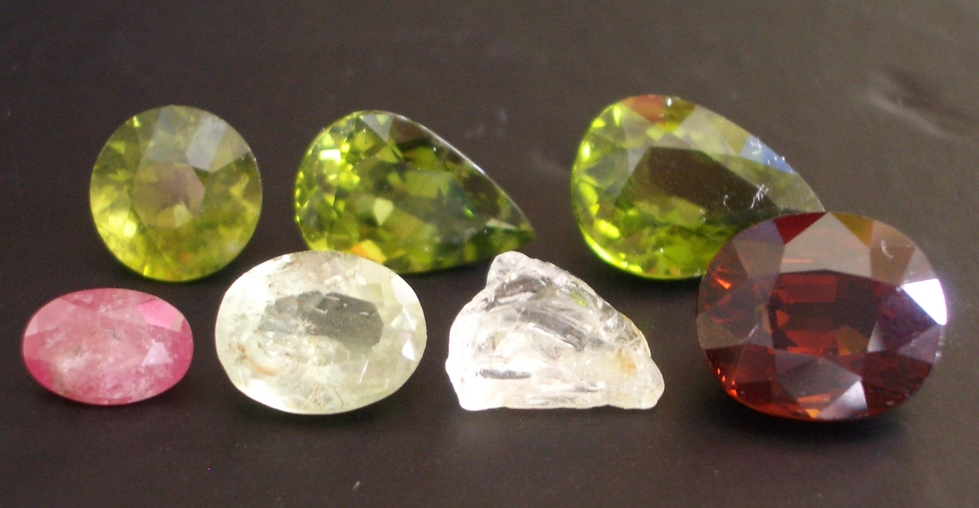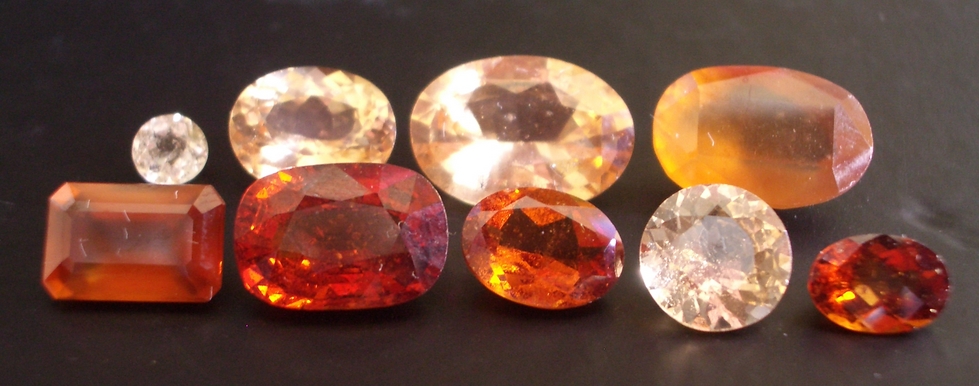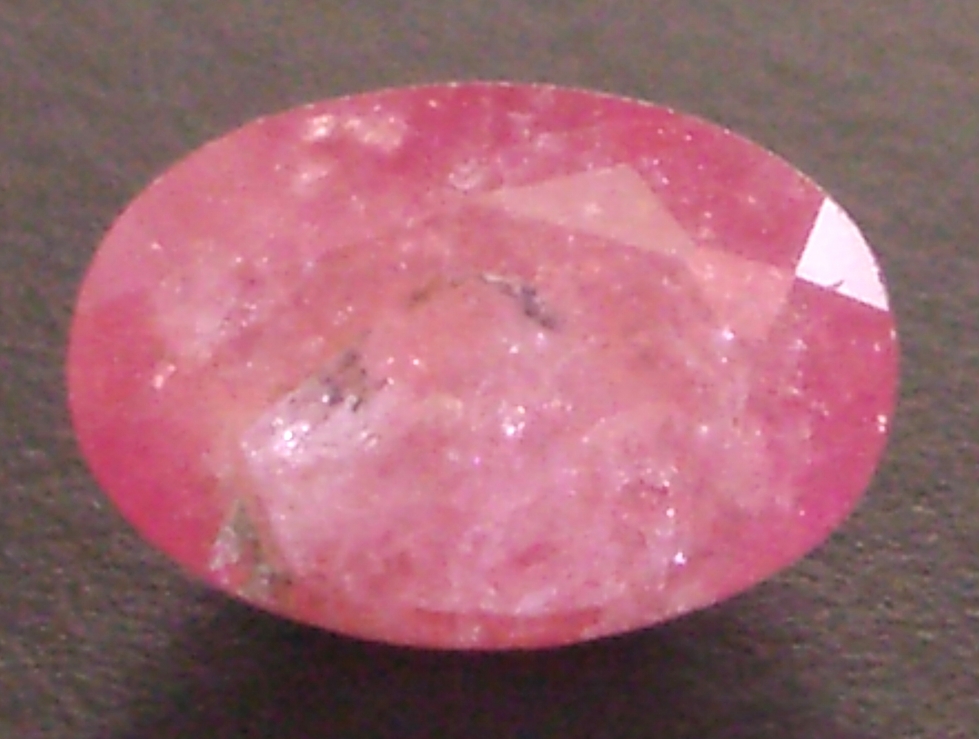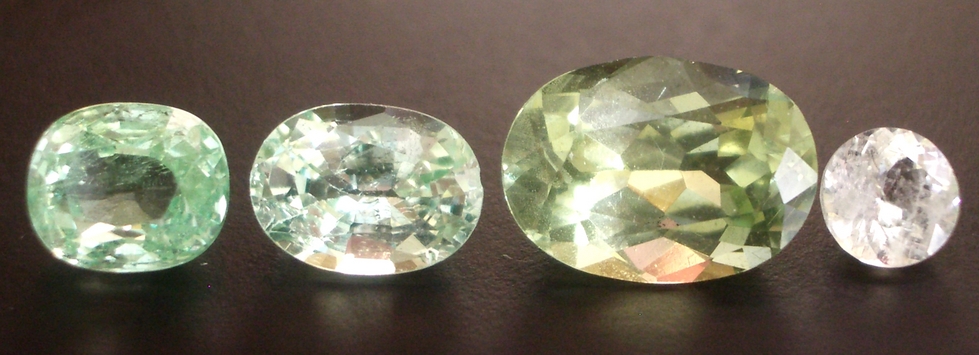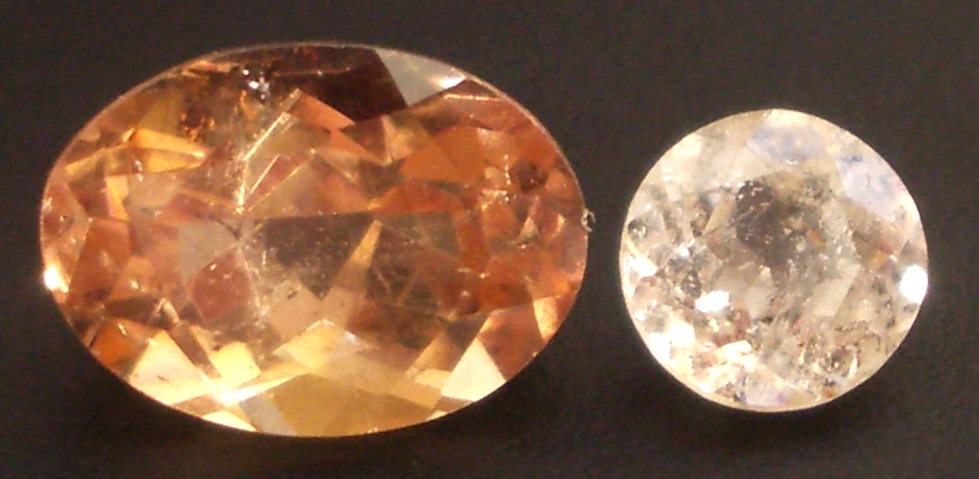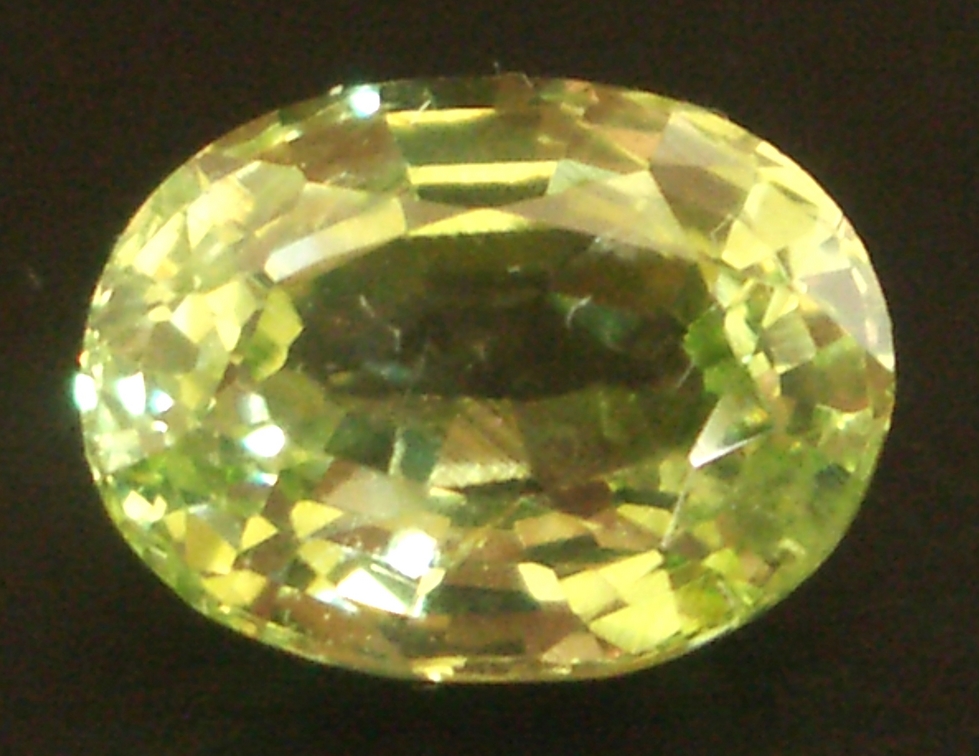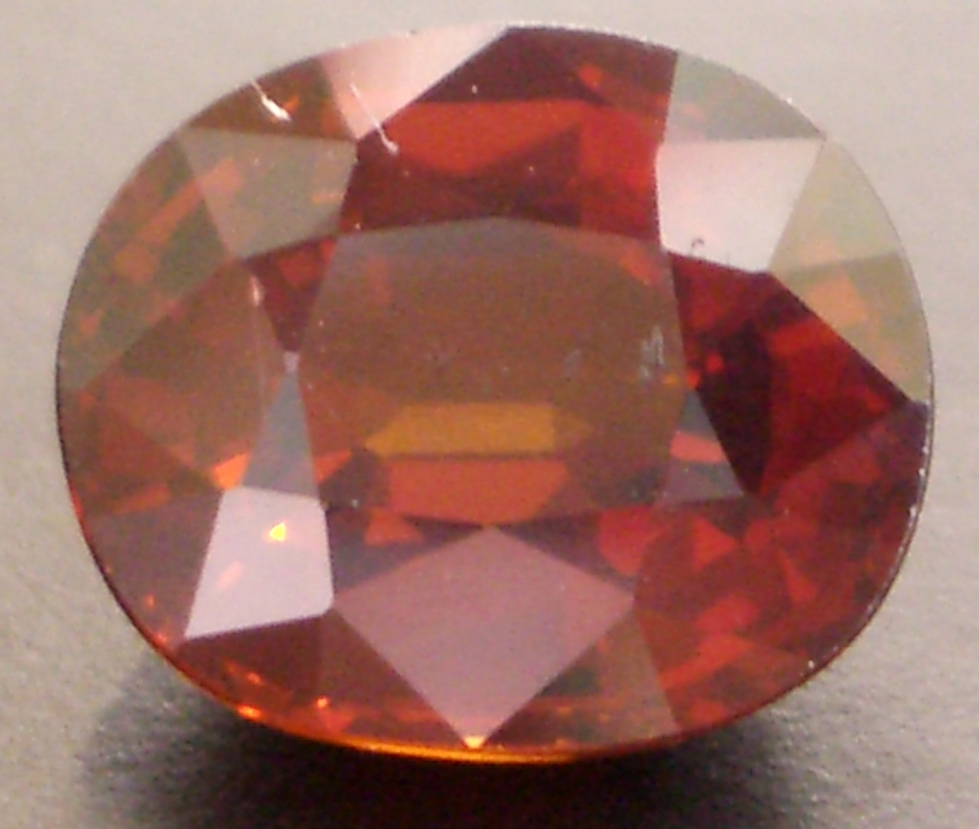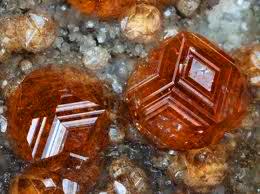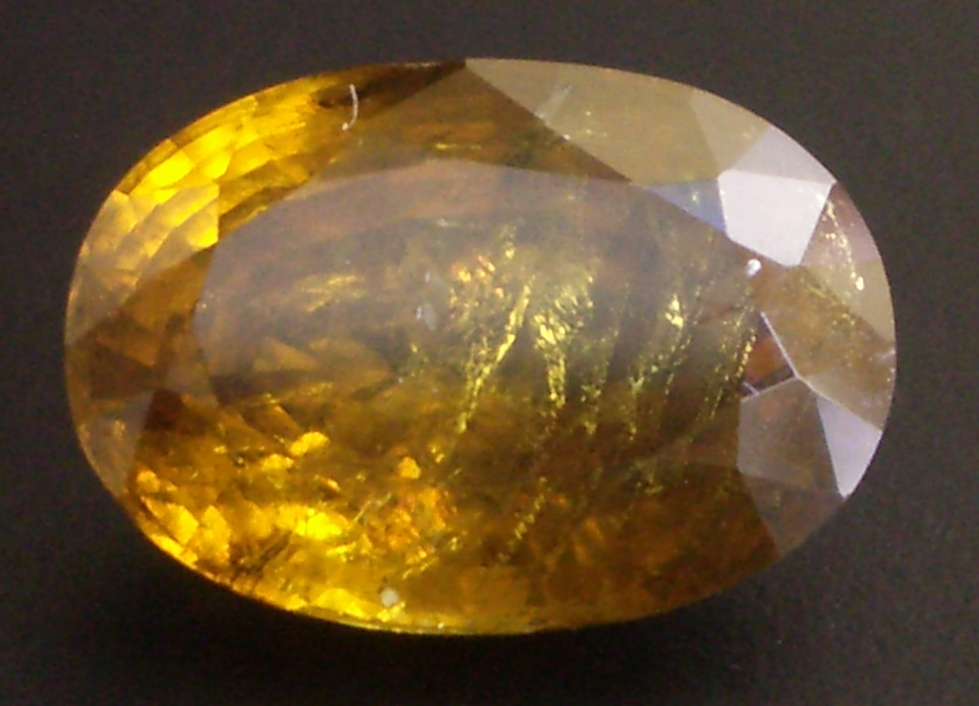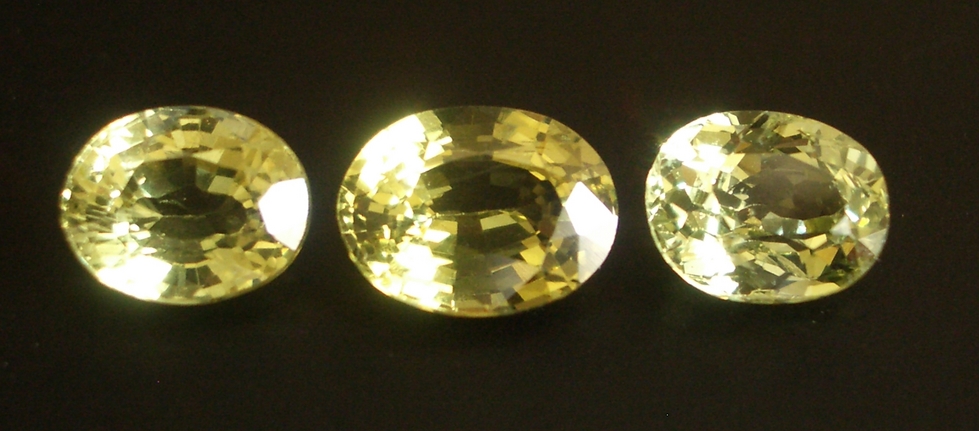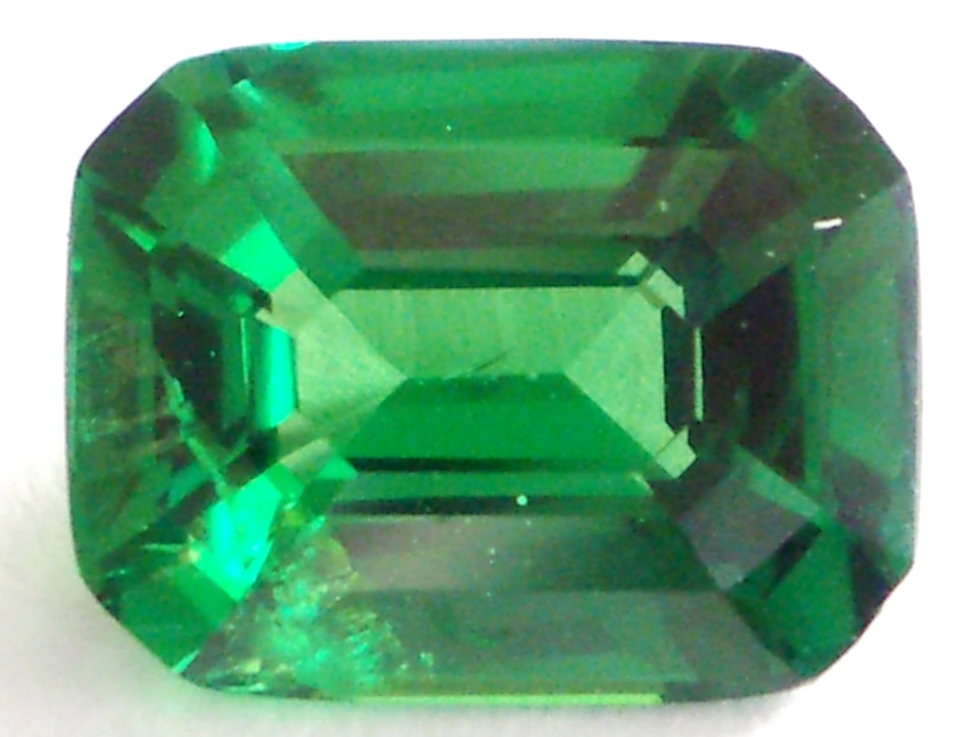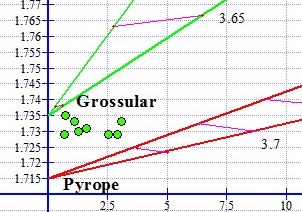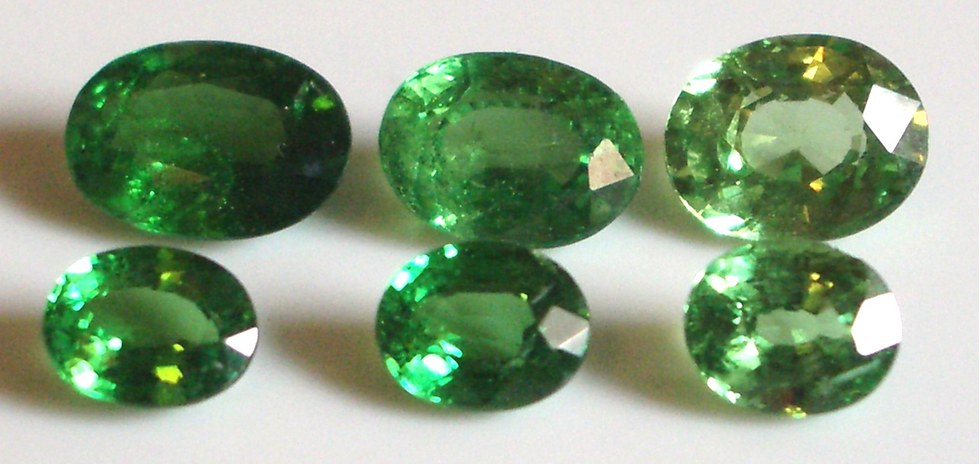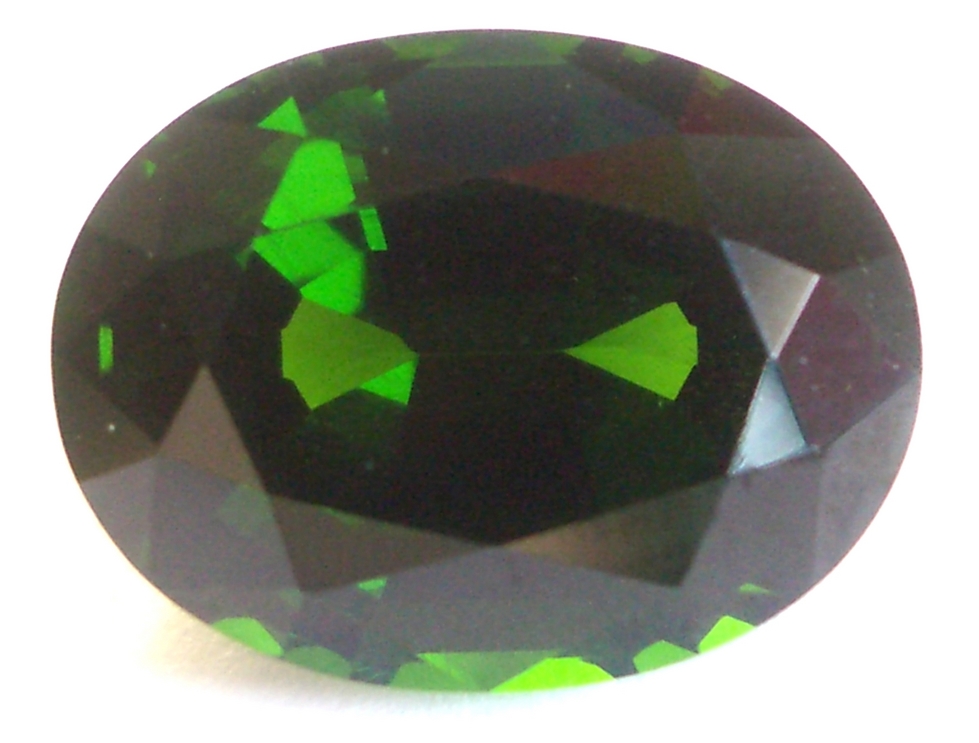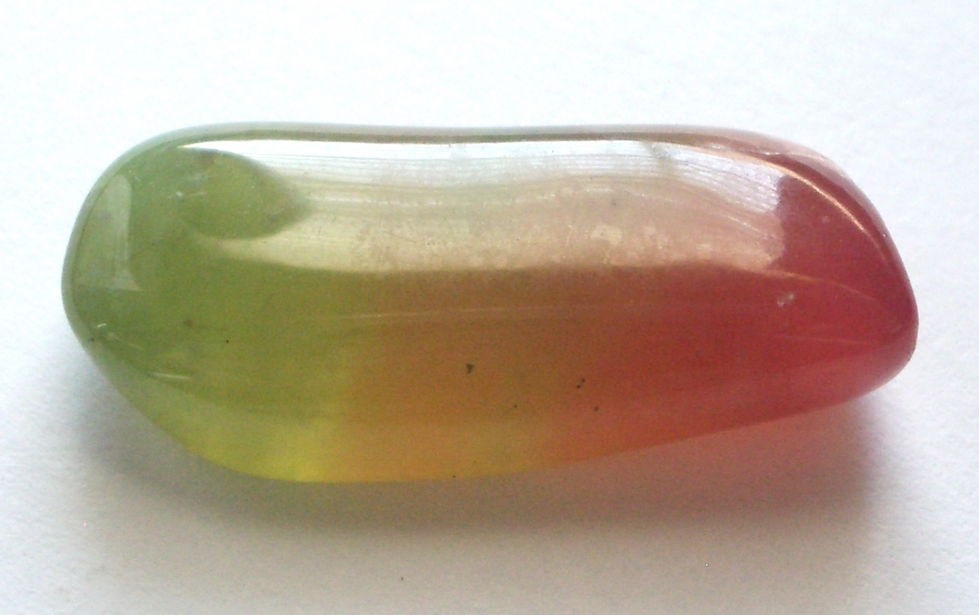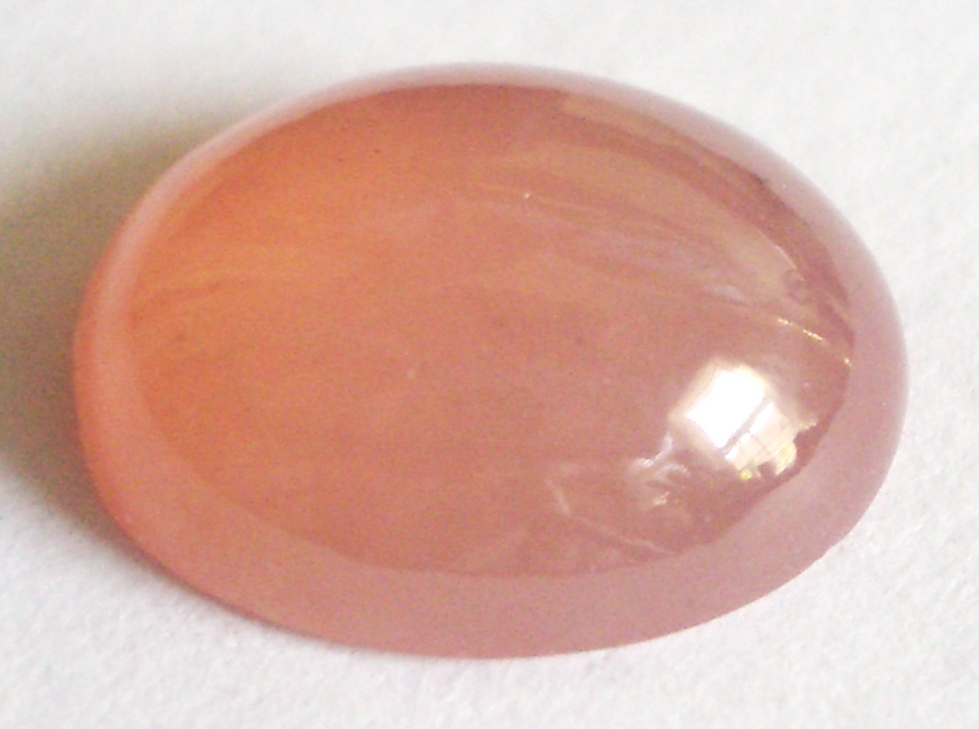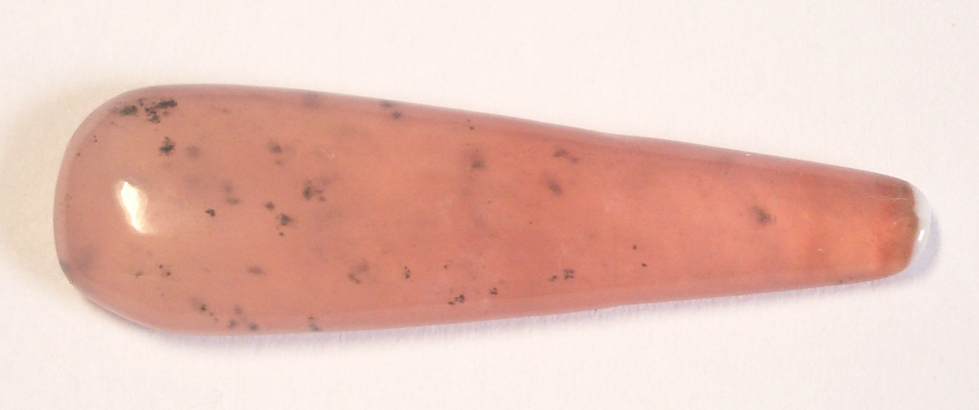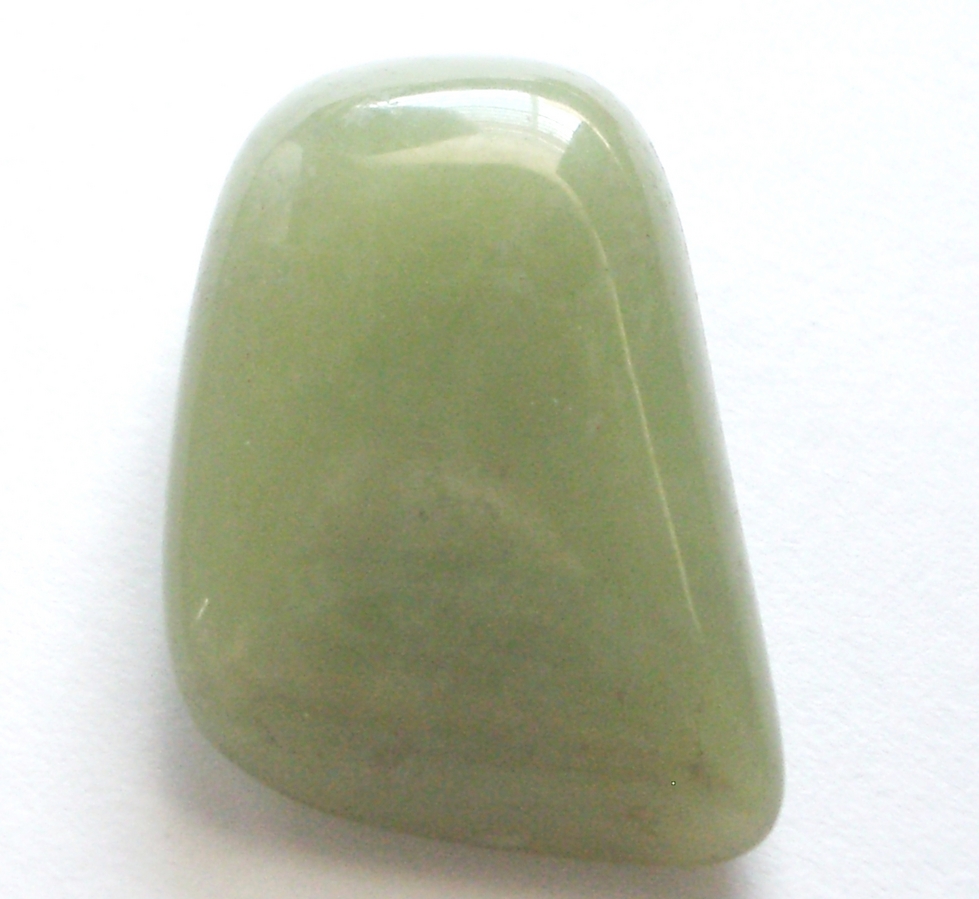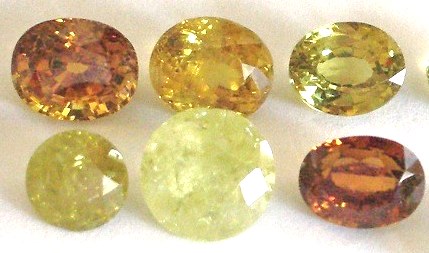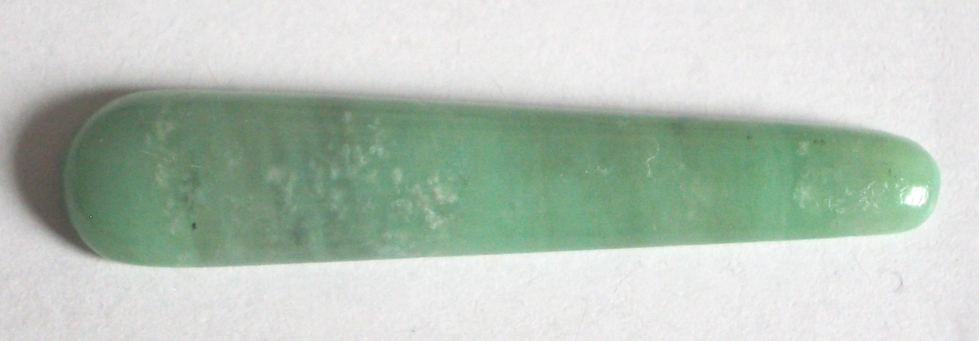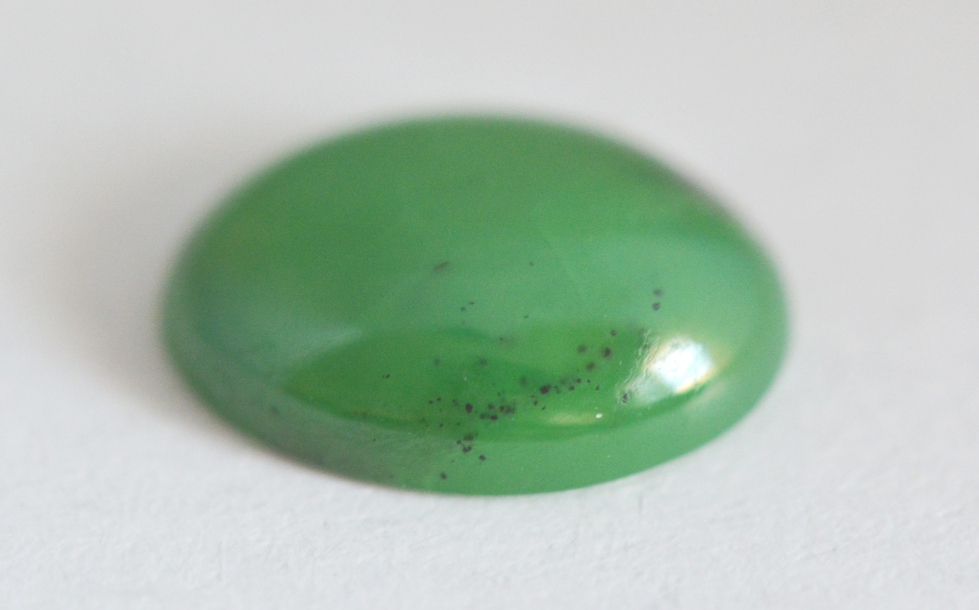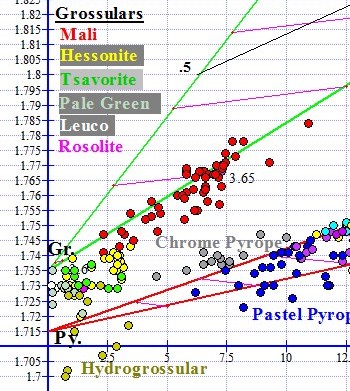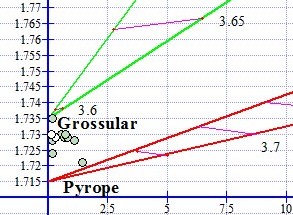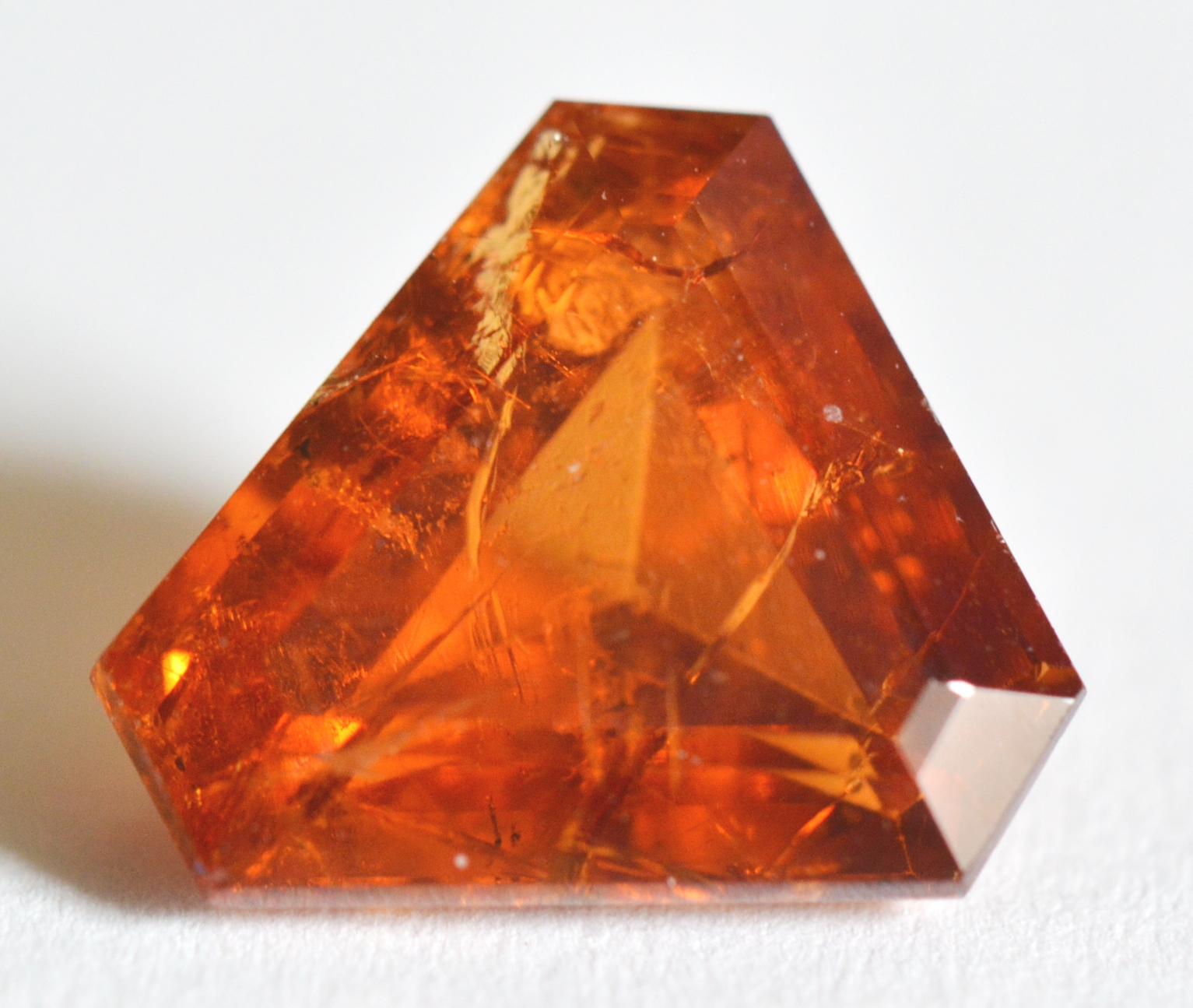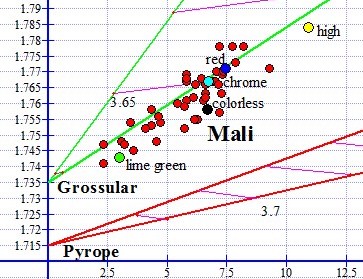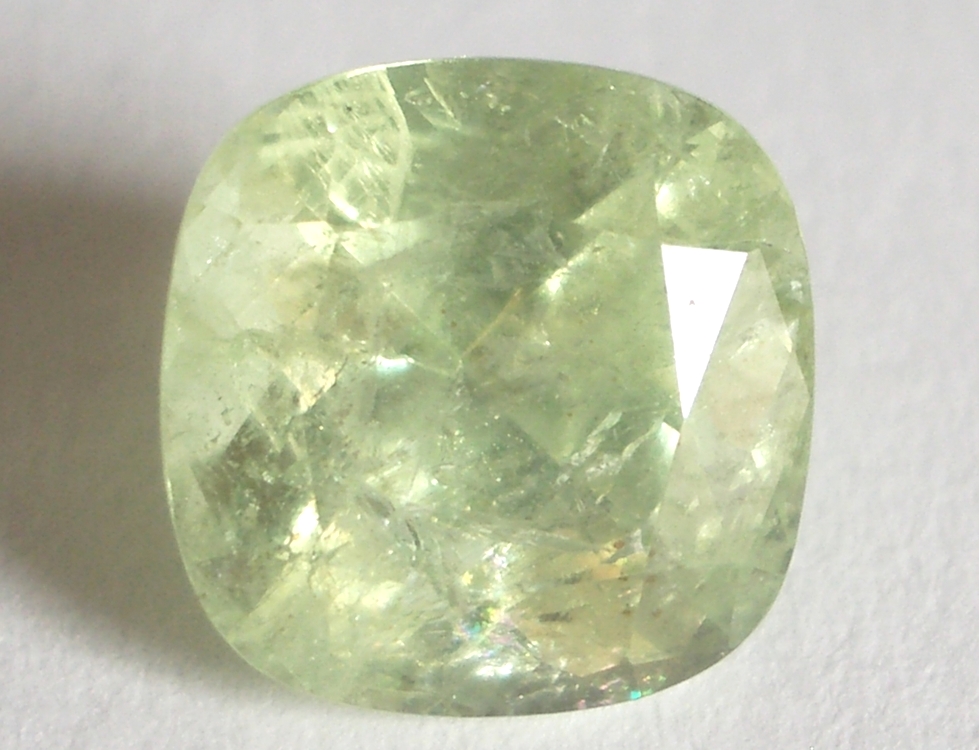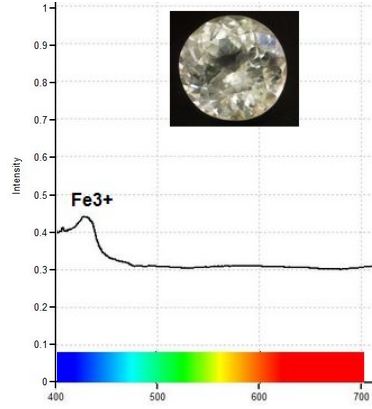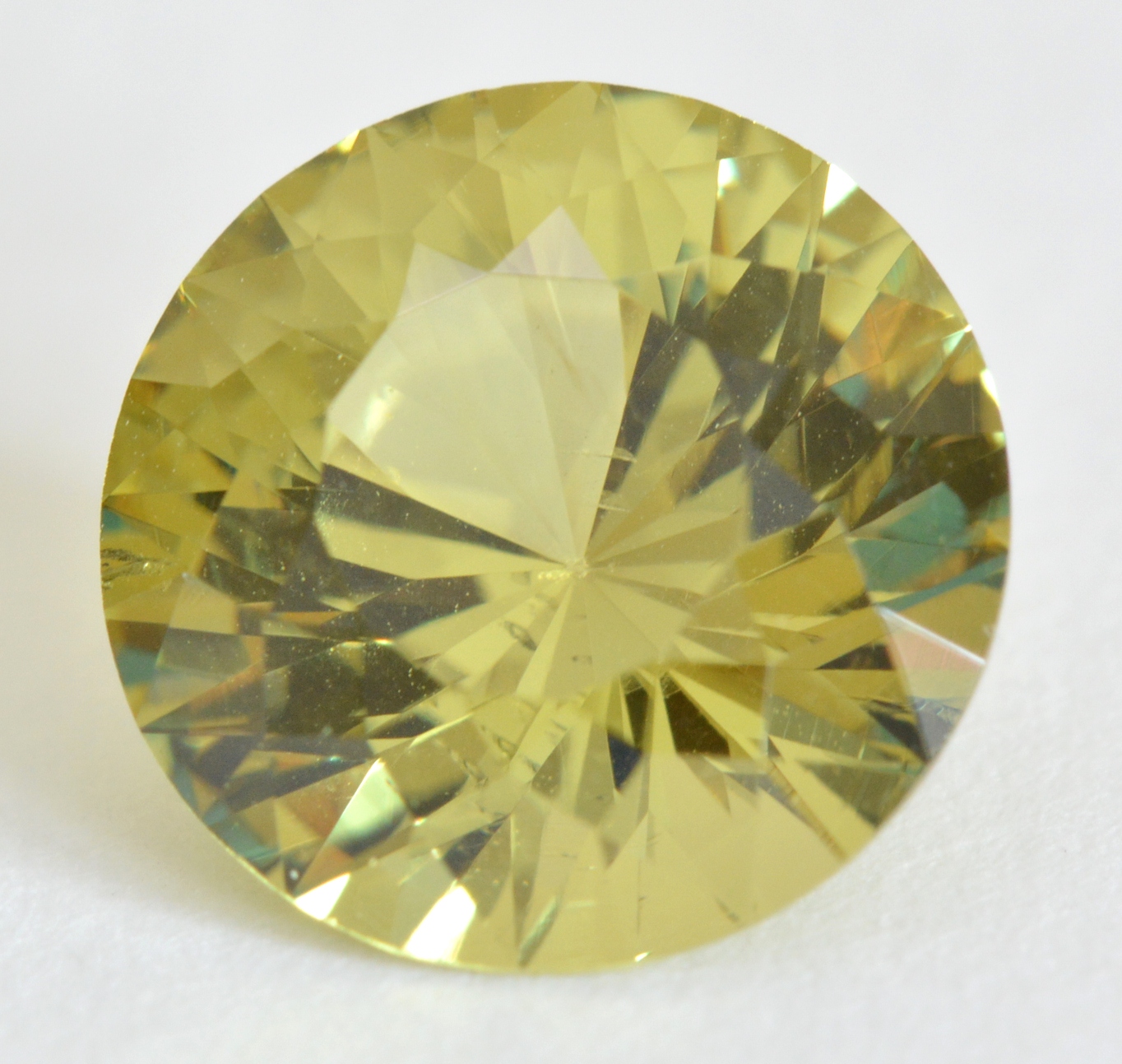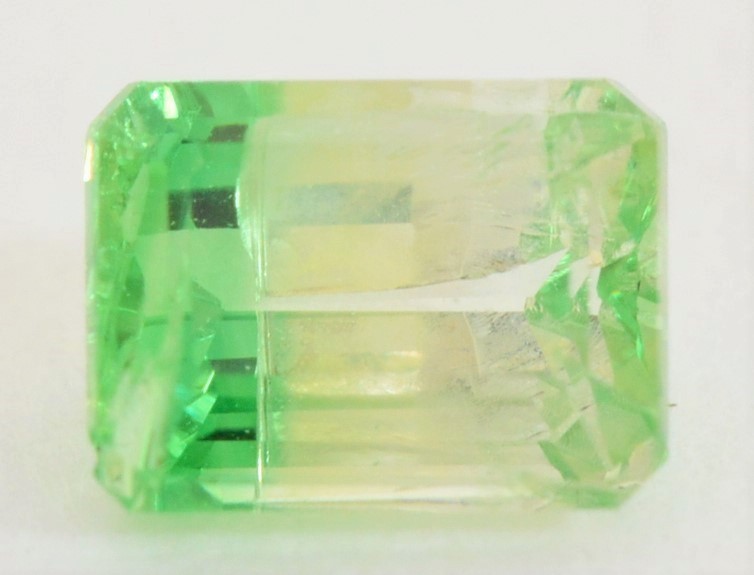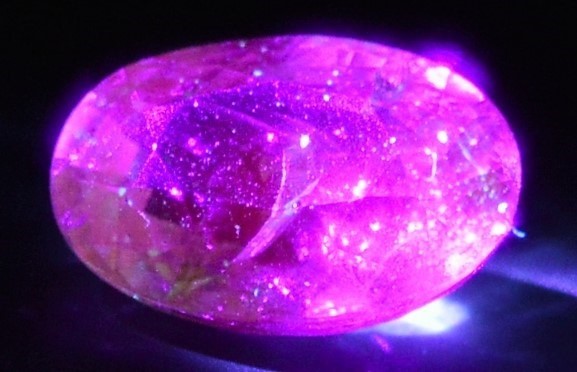Grossular Graph Points
Hydrogrossular Garnet: Hydrogrossular Garnet is translucent to opaque micro-crystalline Garnet, often containing black inclusions of the iron/chromium-rich mineral Chromite. Hydrogrossular Garnet is never fully transparent. Translucent gems can have a milky transparency similar to Prehnite or Chalcedony, which are also micro-crystalline minerals. As a gemstone, this massive form of Grossular Garnet is mostly fashioned into cabochons rather than faceted gems. Color is usually green, but also occasionally pink or red. Hydrogrossular can also be colorless or white. Rare bicolor stones that show both red and green phases have been referred to as "Watermelon Garnets", and pink Hydrogrossulars with black specks of Chromite have been called "Strawberry Garnets". When tested with a pinpoint wand, black Chromite inclusions, as seen in the pink gem below (right), show a stronger magnetic response than the body of the gem.
It's interesting that most Grossular graph points above also fall well below the Grossular-Andradite join toward Pyrope. This is primarily due to Grossular mixing with Hydrogrossular Garnet, rather than due to mixing with Pyrope as you might guess. We have seen that Pyrope Garnets can have significant Grossular content, but chemical studies have shown that the reverse is not true. Gem-grade Grossular Garnets do not freely mix with Pyrope, and Pyrope content is usually well under 5% (Manson/Stockton 1985).
Grossular Garnets
Translucent Pink Hydrogrossular Cab
4ct., Zimbabwe
Daylight and UV Fluorescence
Transparent and semi-transparent green gems sold as Hydrogrossular Garnet are probably Idocrase (Vesuvianite species) rather than Garnet. The gem below (left) was represented by the seller as Hydrogrossular, but is no doubt Idocrase. Due to a grainy internal texture, this Idocrase gem is not completely transparent, but this degree of clarity is not seen even in the finest examples of genuine faceted Hydrogrossular from Siberia (below right). The 2 photos below compare semi-transparent faceted Pakistani Idocrase with a translucent faceted Siberian Hydrogrossular.
Pakistani Idocrase
Hydrogrossular occurs most often as an opaque to semi-translucent material, which is often sold by the trade name "Transvaal Jade" (from the Transvaal region, South Africa). This form, which can at times be a mixture of Hydrogrossular and Zoisite, is fashioned into carvings and cabochons. The rich green cabochon below right is not a Jade gem, but it does make a convincing natural imitation of green Jadeite or Nephrite. Dark green Hydrogrossular gems have higher refractive indices (1.725-1.728) than lighter green Hydrogrossulars, and their graph points plot closer toward the Uvarovite end member, possibly indicating detectable vanadium/chromium content and/or lower hydrous content content.
"Transvaal Jade" is Hydrogrossular Garnet that Imitates Genuine Jade
Green Grossulars range from dark green gems with the trade name "Tsavorite", to lighter mint-green "Merelani" Garnets, to light yellowish green gems sometimes called "Kiwi " Garnets, to the nearly colorless "Leuco" Garnets that show just a hint of green. All are grouped here as gradations of the Green Grossular color variety. As the graphs below show, Merelani and light green gems tend to plot a bit closer to the pure Grossular end member than dark green Tsavorite gems, apparently due to decreasing iron content. The lighter color apparently correlates with decreasing green color that is derived from a combination of iron and vanadium/chromium. The small amount of vanadium/chromium likely contributes nothing to the measurable magnetic susceptibility.
Tsavorite Graph Points
Tsavorite Garnets
Merelani & Light Green Grossular (light green graph points),
and Leuco Garnet (white graph points)
2 Merelanis, Light Yellowish Green Grossular, Leuco Garnet
Hessonite: Hessonite Garnet is also occasionally referred to in the trade as Cinnamon Stone. These gems often show granular inclusions (likely Apatite) and wavy patterns in the crystal structure as identifying characteristics when viewed under magnification. Colors range from dark reddish orange to light orange to yellow (rare) to near-colorless or colorless (leuco). Hessonites show moderate to strong magnetic responses when floated, and most dark orange gems under 3 ct in weight show a Drag response. Magnetic susceptibility has been measured as high as SI 321. As a color variety of Grossular Garnet, Hessonite on average contains more iron from Andradite than does the Green Grossular variety, but not as much iron as Mali Garnet.
Hessonite (Yellow) Graph Points)
& Rosolite (Pink Graph Point)
Hessonite Garnets
Rosolite: This variety of pink Grossular is also sometimes referred to as "Raspberry" Garnet. The pink graph point above nestled among the Hessonites is Rosolite. The bright pink color of this Garnet is due to a small amount of manganese (Mn3+). We can speculate that the manganese in pink Grossluars may have originally been divalent (Mn2+), and similar to pink/red Tourmaline, over geologic time the Mn2+ may alter to trivalent manganese (Mn3+) by natural gamma irradiation during radioactive decay of an adjacent chemical element. Pink fluorescence under blue laser light is probably due to chromium. Iron ions that induce magnetic attraction in Rosolite are cryptic (don't contribute to color).
Pink Grossulars are primarily mined in the Sierra de Cruces mountains, Mexico, but some are also found in Quebec, Canada. Crystals are usually too small to facet into gems, and transparent gems are extremely rare. Rough crystals are most often translucent to opaque, and often grow over a dark titanium-rich core. Some sources describe the dark core as Andradite Garnet, but a 2017 analysis by GIA shows the core contains approximately 10% Andradite, 23% Morimotoite, 4% Schorlomite, 3% Pyrope, and the remaining 60% mostly Grossular.
Our examination of the black cubic core of one Rosolite crystal (shown below left) is consistent with the finding that the core is primarily Grossular. A pinpoint magnetic wand reveals that the dark core is indeed more magnetic than the outer pink crystal, but the measured magnetic susceptibility is low (SI 239) and well within the range of Grossular Garnet.
Translucent Rosolite Gem 0.54ct
Beautiful Hessonite crystal specimens like the one below (left) are found in Canada. Also shown below right is a faceted "Imperial" Hessonite oval from Canada, and a near-colorless Hessonite round from Tanzania.
Hessonite Crystals
(Jeffrey Mine, Canada)
"Imperial" Hessonite (Canada) &
Near-colorless Hessonite (Tanzania)
Mali Garnet Graph Points
Mali Garnet Suite
The trade name Mali Garnet is used throughout the industry, but it is unfortunate that this Garnet variety was named after its country of discovery. Our study shows that Garnets with Mali composition (averaging 82% Grossular, 18% Andradite) can also be found in other parts of Africa (Nigeria, Tanzania and Madagascar), as well as in Russia, Afghanistan and Brazil, although these gems are never sold as Mali Garnets when the origin is outside Mali, Africa. They are generally sold as Grossular or Grandite or Grossular-Andradite. To add to the confusion, other varieties of Garnet besides Mali Garnet (such as Color Change Garnet) are found within the country of Mali. The Hoover method allows us to uncover such details, which otherwise have not yet been addressed in published literature. Below are photos of two Garnets with Mali composition that are reportedly from Madagascar and Afghanistan.
Yellow Green Mali
(Madagascar 1.5ct.)
Another unusual Mali found in this study shows color change from orangey brown in daylight to red in incandescent light. It is reportedly from Tanzania, and has a high RI (1.771) and a correspondingly high magnetic susceptibility (SI 746). The red color could be due to intervalence charge transfer between iron and titanium (Hoover, pers. comm. 2011). To our knowledge, neither red color, nor the phenomenon of color change, nor Tanzanian origin have been reported for Mali Garnet or Grossular-Andradite in any published literature. We have tested two other Malis with red color, one with high Andradite content (it picks up with a magnet) and one at the other end of the Mali range with very low Andradite content. This variability in iron content is further confirmation that the color of Grandite gems is independent of the total concentration of iron (Fe3+).
Near-colorless Mali (4.6ct)
Red Color Change Mali from Tanzania
(2.7ct) in Incandescent Light
Mali Garnet gems have more Andradite content than other Grossular varieties, but since most have a chemical composition that is overwhelmingly Grossular, Mali Garnet are best classified as a variety of Grossular rather than as Grossular-Andradite (which is the designation currently used by GIA). We have found only a few Malis with RI's above 1.77. The highest (1.784) is the Mali pictured below right. Its high graph point, shown in yellow on the graph below left, shows an unusually high Andradite content of approximately 33%.
High RI Mali
(Yellow Graph Point)
© Kirk Feral 2011, All Rights Reserved. These materials may be duplicated for educational purposes only. No part of this website may be duplicated or distributed for profit, for commercial purposes, or for posting to another website without the expressed written consent of the copyright holder.
Unusual Yellow "Imperial" Hessonite (India)
The Ugrandites: Part 2
Grossular Garnet
Grossular Garnet is the Ugrandite mineral species that is primarily fashioned into gemstones. It is a diverse species, with more color varieties than any other species of Garnet. Gem colors span the spectrum from colorless (transparent) to black (opaque), but no true blue or purple gems are known. Hessonite and Tsavorite Garnets are the color varieties most often seen in the gem trade. Due to traces of chromium and manganese, orangey pink fluorescence under long wave UV light is common in many light-colored Grossulars.
Mali Garnet: Mali Garnet gems can be visually stunning due to high dispersion that rivals Demantoid. Classified by most gemologists as Grossular-Andradites, Malis are yellowish green to brown, with dark brown gems having the highest Andradite (iron) content. Though rare, dark green and light "mint" green colors have also been observed. We also find brownish orange, brownish red, and brownish yellow gems. Inter-valence charge transfer likely plays a role in color in Mali Garnets.
Due to their higher iron content, most green Mali Garnets do not show chromium fluorescence under long wave UV light, but a Chelsea filter reveals that traces of chromium are common in all colors of Mali Garnets, including brown Malis. This Garnet variety was discovered in the West African country of Mali in 1994, and the first description and analysis of this Garnet's composition was published by Mary Johnson, et al. in the Fall 1995 issue of Gems & Gemology.
Pictured below is a large near-colorless Mali Garnet, also at the low end of the Mali range. This low Mali (or high Leuco Grossular) has a refractive index of 1.749, and the magnetic susceptibility is SI 3.47. The spectrometer graph beneath the photo clearly shows the presence of Fe3+ in the absence of vanadium/chromium. The concentration of vanadium/chromium is probably below the threshold needed to produce color, and all of the faint yellow-green color and measured magnetic susceptibility is likely due to iron. The trivalent iron (Fe3+) found in all Ugrandite Garnets is a weak chromophore.
Typical Greenish Yellow Mali Garnets
Brownish Yellow Mali
(Afghanistan 1.70ct.)
Dark Green Chrome Mali 5.2ct
Color Varieties of Grossular
Green Grossulars: The deep blue-green color of Tsavorite Garnet (shown below left) is similar to the color of fine Emerald. Like Emerald, Green Grossulars are colored primarily by vanadium and chromium in varying proportions, although vanadium is generally the dominant chromophore in Green Grossulars. Iron (Fe3+) may also be involved to a minor extent in contributing green color. Gems with a very low concentration of vanadium/chromium can appear light green, as we see in the Merelani Garnet shown below (right).
Tsavorite from Tanzania
Closely Resembles Emerald
Hydrogrossular Garnet and Idocrase are chemically very similar, and these two minerals can inter-grow within the same stone. Both minerals can be translucent to opaque, and have similar appearance, refractive index, magnetic susceptibility and specific gravity values, making it impossible to distinguish between them using standard instruments. Idocrase is doubly refractive, but it falsely appears singly refractive (like Hydrogrossular) under the polariscope and refractometer. Translucent green gems such as the two Hydrogrossulars (reportedly) shown below (left and center) cannot be distinguished from translucent Idocrase (reportedly, shown below right) without sophisticated lab tests. Idocrase on rare occasion may also appear pink.
Translucent Idocrase
"Pulga Jade" from California
Translucent Hydrogrossular
from South Africa
Green Hydrogrossulars are colored by a combination of iron and vanadium/chromium, while pink and red Hydrogrossulars appear to derive their color from manganese (Mn3+), as does Rosolite Grossular Garnet. Colorless Hydrogrossular does not contain sufficient chromophores (vanadium/chromium or manganese) to produce color, yet the example below (right) is still moderately magnetic (SI 143) due to cryptic iron (Fe3+).
Bi-color Hydrogrossular "Watermelon" Garnet
Hydrogrossular Garnets contain a hydrous (structural water) component, which lowers refractive index and density. Water content can be 5% or higher. Grossular is in solid solutions series with the Hydro-Garnet species Hibschite, which is a non-gem Garnet that has hydrous content. This simply means hydrogen and oxygen (OH) partially replace the silica component (SiO4) in the chemical formula of Grossular.
The khaki-green graph points located at the bottom of the graph below show that Hydrogrossulars fall well below the Grossular end member (green ternary), with the lowest RI being 1.70 among samples we tested. Hydrogrossulars are positioned toward the hydrous end member Hibschite, which is below the range of the graph (the refractive index of Hibschite starts at 1.67). However, Hydrogrossular is classified as a variety of Grossular, since Grossular is the primary component in these gems.
"Strawberry" Pink Hydrogrossular
Translucent Green Hydrogrossular
31ct.
Green Hydrogrossular
Siberian Hydrogrossular
Photo Courtesy of Osirisgems.com
The transparent dark green Chrome Mali shown below also derives its dark rich color primarily from vanadium/chromium. This gem shows typical Grossular-Andradite composition on the RIMS graph. Although the vanadium/chromium is apparent with a spectrometer, the low concentration of vanadium/chromium in this gem does not elevate the refractive index or magnetic susceptibility, and therefor the vanadium/chromium content is not detectable using the RIMS method.
Hydrogrossular Graph Points
Hessonite (Imperial Valley, California)
Green Mali
"Mint" Green Mali
Light Orange "Imperial "Hessonite (Sri Lanka)
Daylight and UV Fluorescence
Red and dark orange colors may also result from inter-valence charge transfer involving iron (Hoover 2013, pers. comm). Color-saturated orange gems are sometimes referred to in the trade as Tangerine Garnets, Fanta Garnets and Mandarin Garnets. Gomed is a term used for brownish orange Hessonites found in India.
The trade name used for gems with light orange color is "Imperial" Hessonite, and these light orange Hessonites fluoresce pinkish orange under longwave UV light. Our studies with photoluminescent spectroscopy show that fluorescence is primarily due to trace amounts of manganese (Mn2+), although chromium can also contribute a pink component to fluorescence. The reason for an absence of fluorescence from manganese in dark orange and reddish orange Hessonites is not known. But since darker Hessonites tend have higher magnetic susceptibility, we can speculate iron content is sufficient to quench fluorescence.
Iron in Near-Colorless Mali
Yellow Mali
Translucent Red Hydrogrossular
4.07ct., South Africa
Rosolite Crystal Specimen with a Dark Core
Near-Colorless Grossular Garnet: Colorless and near-colorless Grossular Garnets are rare. The two gems pictured below are examples of a near-colorless greenish yellow Grossular (left) and a near-colorless yellowish green Grossular (right), both from Tanzania. Both gems have much less iron and magnetic susceptibility than do Mali Garnets, with compositions near the pure Grossular end member. Both of these gems fluoresce orangey pink in longwave UV light due to manganese and chromium in the presence of very low iron content. Higher iron and/or vanadium content likely would quench fluorescence.
Leuco Garnets in Daylight and UV Light
The concentration of vanadium/chromium and manganese in all the above near-colorless Grossulars and Leuco Grossulars is too low to contribute to measurable magnetic susceptibility. The low magnetic susceptibilities measured are due to entirely iron (Fe3+), and susceptibility values range from just SI 0.15 to SI 1.27 X 10(-4). Magnetic responses range from Weak to Moderate. We have not found any near-colorless Grossulars or Leuco Grossulars that are magnetically inert (diamagnetic).
In all cases, refractive indices of near-colorless and Leuco Grossulars were under 1.735. The major chemical compositions (percentage of Grossular vs. Andradite) of these Grossulars are consistent with compositions of light orange Hessonites and light green Grossulars (see the white Leuco graph points on the graph below).
Leuco Garnet Graph Points
Bicolor Garnets are very rare, particularly transparent Garnets that show distinct lines of color separation, as seen in the bicolor Leuco Garnet from Tanzania pictured below. This Garnet shows bright green Tsavorite color on the left side due to iron and vanadium/chromium, and colorless Leuco color (no color) on the right due to insufficient chromophores. This gem is weakly magnetic on both sides, but when tested with a pinpoint magnetic wand, a slightly stronger magnetic response can be detected on the green side (due to slightly more iron rather than to more vanadium/chromium). Fluorescence under longwave UV light appears strongest on the colorless side that has less iron and less vanadium.
Bicolor Leuco Garnet, Tanzania
"Merelani Mint" Grossular
Kenya
Translucent Hydrogrossular
from Afghanistan
Leuco Garnet: Leuco simply means colorless. All Leuco Garnets in our study originated in Tanzania. In most cases, Leuco Grossulars show some remnant of color, either a faint green tint likely due entirely to vanadium/chromium, or a faint orange or yellow tint due to manganese (Mn2+). The iron (Fe3+) content is cryptic, producing no visible color. Some Leucos appear completely colorless, and can be up to 99% pure Grossular. Completely colorless Garnets still show weak magnetic attraction due to a low level of cryptic iron.
The three Leuco Garnets pictured below contain manganese and vanadium/chromium in such low concentrations that little or no color is apparent. Yet these gems contain enough chromium (from mixing with Uvarovite) and manganese (from Spessartine) to fluoresce orangey pink under UV light. Most of the Leuco gems tested in our study - whether colorless, faint green or faint orange/yellow - show strong fluorescence under longwave UV light. Pinkish orange fluorescence in Leuco Garnets with faint orange daylight color is primarily due to manganese, while orangey pink fluorescence in Leuco Garnets that have a faint green daylight color is primarily due to chromium.
Yellowish Green Near-Colorless Grossular
Tanzania
Greenish Yellow Near-Colorless Grossular
Tanzania
Light Yellowish Green Grossular
Kenya
Green and pink Hydrogrossulars both fluoresce pink or pinkish orange under blue laser light (405 nm), although fluorescence is much stronger in pink hydrogrossular. A trace amount of chromium seems to be the main fluorescence activator in both colors of Hydrogrossular. Divalent manganese (Mn2+) can also contribute a yellow component to the orangey-pink color of fluorescence. Although Mn3+ creates pink body color, it is not known to be an activator or co-activator of fluorescence.
The iron (Fe3+) that causes all of the magnetic attraction in pink and red Hydrogrossulars is probably cryptic, contributing nothing to daylight body color. The pink Hydrogrossular below has the lowest refractive index (1.70) of any Garnet gem of any species or variety tested in this study.
Since iron (Fe3+) content is relatively low in Green Grossular Garnets, fluorescence is not quenched by iron. Orangey-pink fluorescence under long wave UV light due to chromium (pink/red) mixing with a bit of manganese (Mn2+, yellow) can be seen (pink + yellow = orange), and such fluorescence is most apparent in gems with light green color. Although vanadium V3+ rather than chromium Cr3+ or iron Fe3+ is the primary coloring agent in most Green Grossulars, vanadium does not contribute to fluorescence. Stronger long wave fluorescence is seen in lighter Green Grossulars presumably because the concentration of fluorescence-quenching vanadium is lower. We hypothesize that the total concentration of vanadium in dark green Tsavorite Garnets becomes high enough to quench some or all of the chromium fluorescence.
Dark Green Tsavorite Garnet
Daylight and UV Fluorescence
Our study has turned up a number of Mali Garnets from Mali that have unusual color, and we find that color variation (near-colorless, yellow, light green to dark green, brown, orange, red) is broader than what is generally reported for Mali Garnet. It's interesting to note that Mali Garnets with yellow and greenish-yellow color show color change from yellow (related to iron) in warm incandescent light to green (related to vanadium/chromium) in cool LED light.
The refractive index range (RI 1.747-1.784) we found for Mali Garnets is also broader than what was noted in the preliminary study by Mary Johnson (RI 1.752-1.779). On average, Malis have a refractive index of approximately RI 1.76 and an average magnetic susceptibility near SI 600, although magnetic susceptibility in Malis at the lowest end of the RI range can be half as much as the average.
Chrome Malis are rare. These Malis are more pure green than yellow-green, and derive most of their color from vanadium/chromium rather than from iron (Fe3+). The spectrometer graph below left shows both iron and chromium/vanadium in the bright green Chrome Mali from Brazil shown below right.
Chrome Mali, Brazil
Iron and Chromium/Vanadium in Chrome Mali
The unusual "lime" green Mali picture below derives its green color from vanadium/chromium, which is modified toward yellow possibly by manganese. It shows strong pink fluorescence when a blue laser (405nm) is applied. The pink fluorescence is due to chromium. Most Mali Garnets contain too much iron to permit fluorescence under UV light. We have not found fluorescence in any Mali Garnets which have a refractive index higher than 1.75. This unusual Mali has a refractive index of only 1.749, lower than what is generally reported for Mali Grossular, but higher than for all Green Grossular Garnets we tested. The magnetic susceptibility is also at the lowest end of the range at SI 291. We can classify this gem either as a low Mali Grossular or as a high Green Grossular, as the solid solution series among Grossular Garnets is continuous and unbroken.
"Lime" Green Mali
Daylight and UV Fluorescence
Translucent White Hydrogrossular
2.82ct.
The most valued Grossular Garnet is Tsavorite (shown below left), a dark green Grossular variety mined in Tsavo National Park, Kenya. Tsavorite color is primarily derived from vanadium (approx. 80%) along with chromium (approx. 20%). Unlike Tsavorite, the light yellowish green Grossular from Kenya shown below is probably colored primarily by iron (Fe3+) or charge transfer processes involving Fe3+ rather than by vanadium/chromium. Such yellowish green Grossulars have been referred to by the trade name "Kiwi" Garnet.
On the African continent, colorless Leuco Garnets and near-colorless versions of Green Grossular, Hessonite and Mali Garnets are found. Such Garnets have low iron content and only a trace of color.
Like gem Andradite gems, gem-grade Grossular gems are Grandite Garnets. They are in solid solution primarily with Andradite (Fe3+), and only to a minor extent with Goldmanite (V3+) and Uvarovite (Cr3+). We have not yet encountered any gem-grade Grossular Garnets that are Gruvites (primarily a mix of Grossular and Uvarovite). Grossular Garnets have low magnetic susceptibilities compared to all other Garnets. The species as a whole does not pick up with an N52 magnetic wand, and most varieties require floatation for any magnetic attraction to be visible. Only Mali Garnets typically show a direct Drag response. As you can see in the graph below, most Grossular graph points fall relatively near the pure end member, which would be magnetically inert (diamagnetic), colorless and completely lacking in iron (Fe3+), vanadium (V3+) or chromium (Cr3+).
Color in Hessonite is due to small amounts of manganese and iron, and gem color can at times be nearly identical to Spessartine. The light orange and yellow hues likely correspond to varying concentrations of Mn2+, and to intervalence charge transfer processes involving manganese.
Hessonites with lighter color tend to plot closer to the pure Grossular end member, showing lower magnetic susceptibility than darker Hessonites, suggesting that darker orange color in Hessonite is associated with higher iron content. Also as a result of higher iron content, some dark orange Hessonites show a Drag response to an N52 magnet, while lighter orange gems must be floated for any magnetic attraction to be visible.
Dark Green Tsavorite
Kenya
Other green Grossulars ranging in color from light green to dark green are also found in limited quantities in other regions of the world such as Quebec, Canada, and Utah in the United States. Quite a few other color varieties of Grossular (colorless, pink, green, orange) have been found in the Quebec mines such as the famous Jeffrey Mine and Oxford Nickel Mine, but the rough crystals are generally small, and few have been faceted as gems.
This concludes our discussion of the Ugrandite Garnets. The next page focuses on how we can distinguish between different species and varieties of Garnet using standard gemological instruments.
Magnetism in Gemstones
An Effective Tool and Method for Gem Identification
© Kirk Feral

